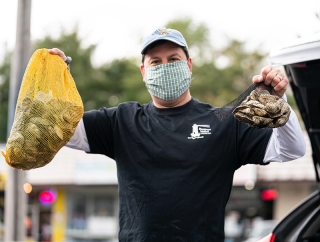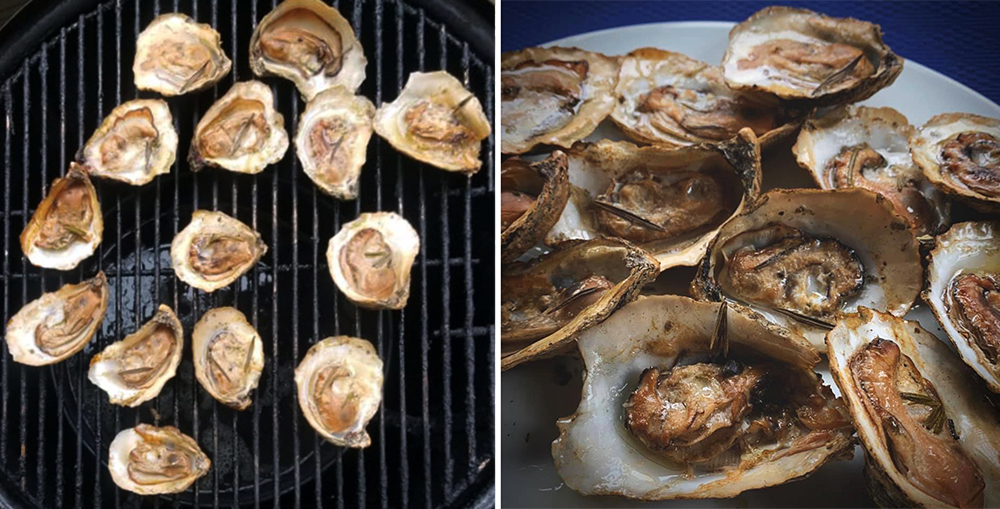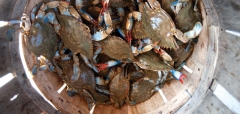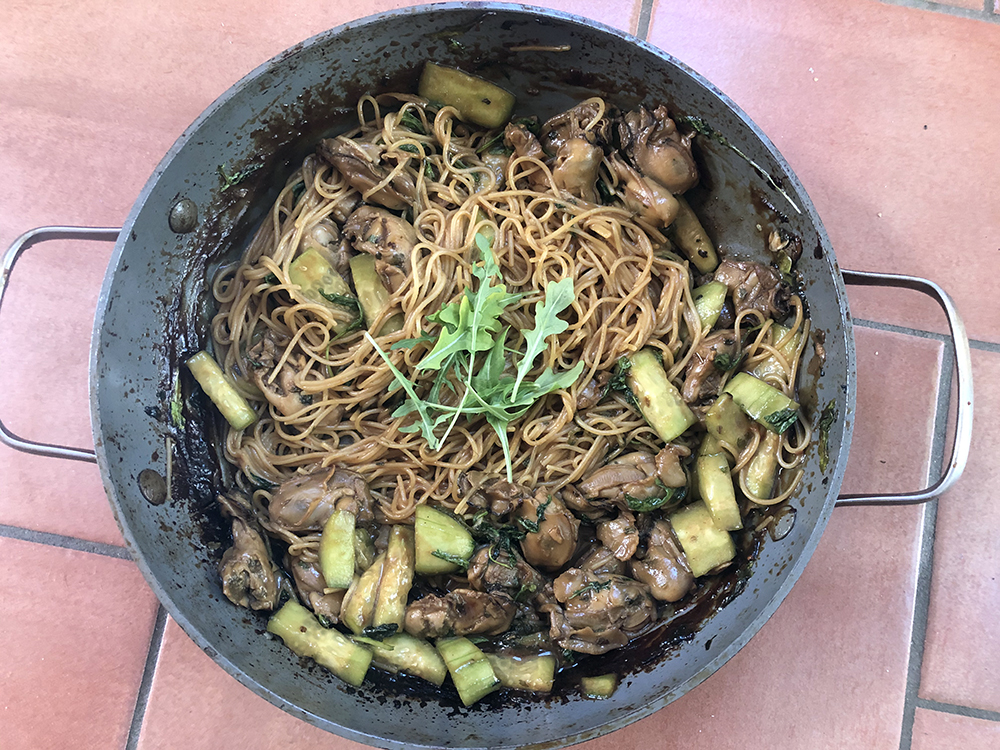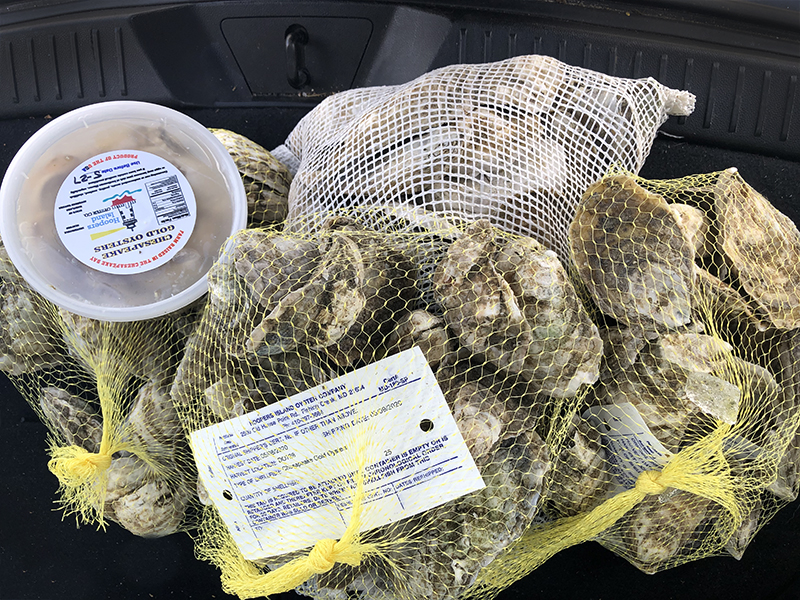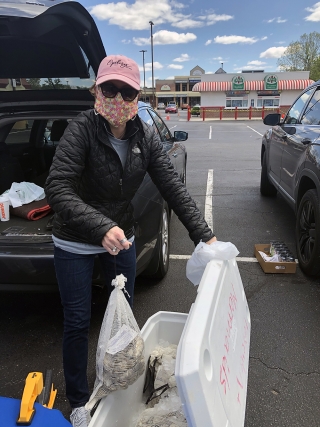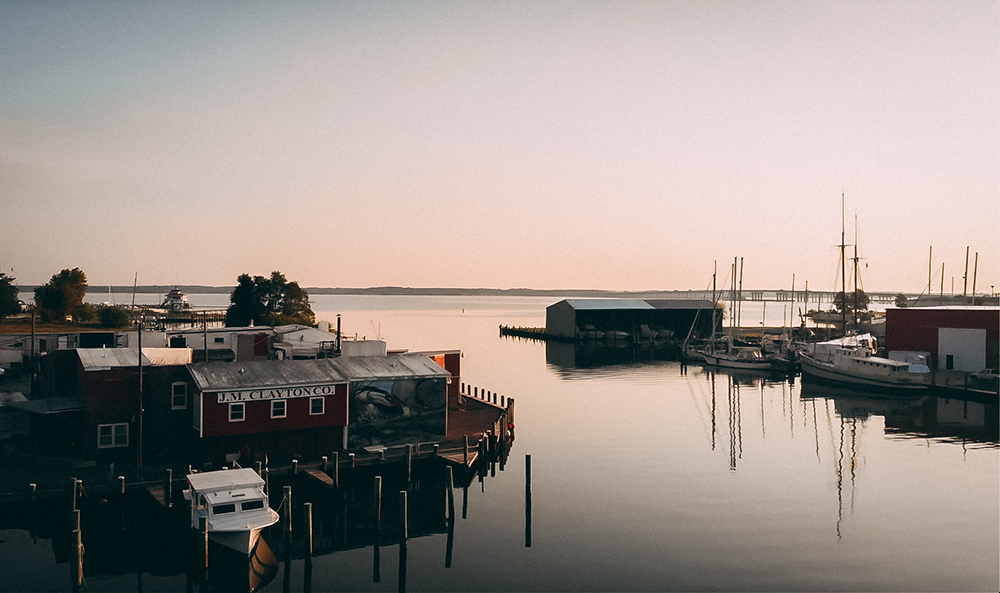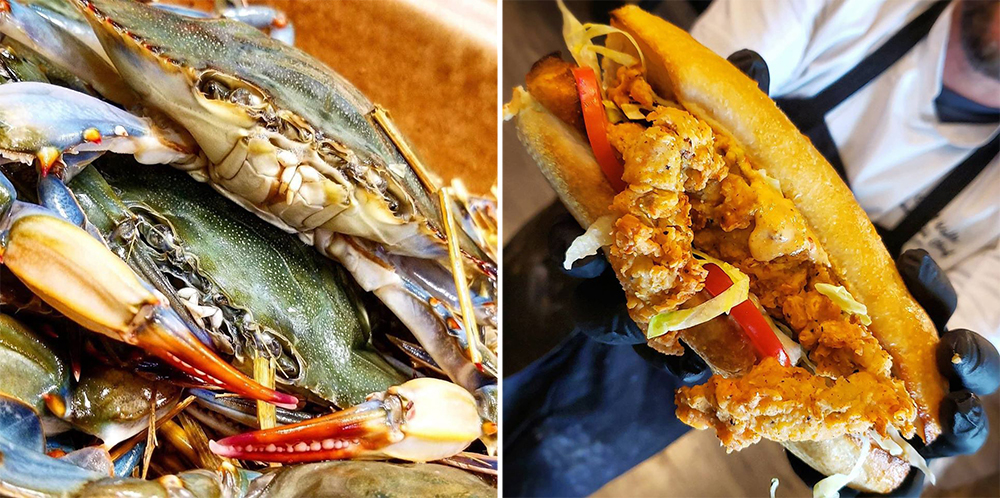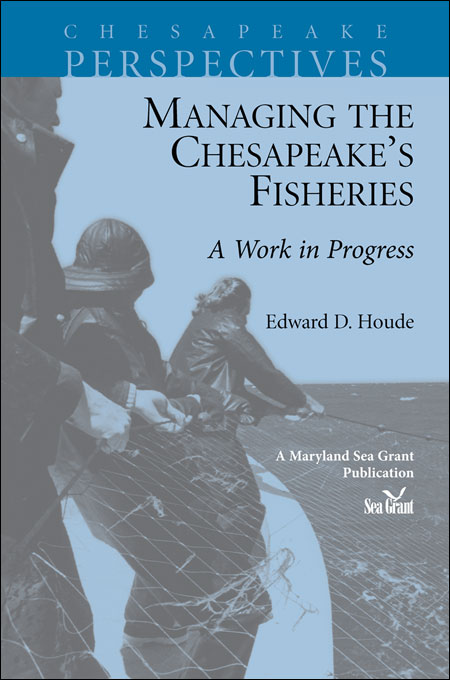Knauss legislative fellowships in Congress help build careers — and they're fun and educational. See our video and fact sheet for details.
Maryland Seafood Lures in the Home Cook: Seafood purveyors try more direct routes to customers
Ordinarily at this time of year, Kit Waskom Pollard is cooking oysters. Grilled in the backyard, sprinkled with rosemary and sea salt, their aroma signals one celebration after another: Easter, Mother’s Day, her father’s birthday, maybe an engagement or a graduation.
“Anytime we’ve ever had a party at our house, we’ve had oysters as a part of it,” said Pollard, a food writer who grew up on the water in Severna Park, Maryland, and now lives in Baltimore. “When people come here, they expect there will be oysters.”
But there are no crowds in Pollard’s backyard now, nor anywhere else where Marylanders traditionally gather to consume seafood. When the coronavirus outbreak hit, Maryland Governor Larry Hogan banned large gatherings and ordered restaurants and bars to either shut down or move to carry-out only. Since then, Maryland seafood has been trying to reinvent itself for a population that is cooking at home more.
On the federal level, the Coronavirus Aid, Relief, and Economic Security (CARES) Act authorizes the Secretary of Commerce to provide $300 million in appropriated funds to assist fisheries affected by the virus, which NOAA Fisheries, an office within the Department of Commerce, will help to distribute. But many in the Chesapeake Bay industry say it won’t be nearly enough to make up for what they have lost. To survive, they have to adjust creatively to a radically transformed marketplace.
Changing Foods
Looking for local seafood?Here are a few resources:
The Maryland Department of Agriculture is the state agency in charge of seafood marketing. Under the banner of “Maryland’s Best,” they have launched a “Keep Calm and Carry Out” campaign that promotes local seafood. They have a state-wide map showing companies offering direct seafood sales and farmers markets.
The East Coast Shellfish Growers Association provides an online resource to assist consumers in finding shellfish and kelp growers and dealers.
Visit Maryland, a site from the Maryland Office of Tourism Development, is maintaining a list of state restaurants offering carry out and delivery, many of whom sell seafood.
The Oyster Recovery Partnership has a list of oyster farms that sell direct to consumers on its page.
Before the pandemic, Americans were increasing their consumption of seafood. According to NOAA’s annual Fisheries of the United States Report, the average American ate 16.1 pounds of fish and shellfish in 2018—a jump of 0.1 pounds apiece over 2017.
But we were far more likely to consume seafood in a restaurant than eat it at home. With restaurants limited to providing carry-out orders, shellfish farmers, watermen, crab processors and restauranteurs are pondering new ways of marketing their products to home chefs. Matt Parker, an aquaculture business specialist with Maryland Sea Grant Extension, believes that moving to “value-added” products could help. Phillips Foods, Inc., an international company with local roots on the Eastern Shore, has “oysters in the oven” products of frozen, packed raw oysters on the half shell with different toppings, branded as wild-caught “Deal Island Oysters.” Chesapeake oysters could move in that direction, Parker believes, becoming more of a dinner staple. With people looking to oven-ready foods, an oyster already shucked and prepared could become more appealing.
Such endeavors could take seafood, particularly oysters, back to the place they occupied in the 19th century: an inexpensive protein, already processed, canned, and easy to prepare. Today we eat oysters as delicacies. But back then, “they were a commodity going to feed this industrial maw,” said Kate Livie, author of Chesapeake Oyster: The Bay’s Foundation and Future.
Oysters were much larger then—today they’re rarely sold at larger than three inches, which is market size. Livie thinks a larger commercial oyster could be appealing and a way to find new markets for oyster farmers.
Parker, who recently earned his doctorate in marine estuarine environmental science as part of the MEES Graduate Program within the University System of Maryland, agrees growing larger oysters could mean more products, and he believes more shucked oysters for home cooks could expand markets.
“You’ve got to go to those areas that are not traditional oyster areas,” Parker said, adding that trains from Baltimore used to transport packed and shucked oysters to the Midwest throughout the 19th and 20th centuries. “There are people who like oysters in the middle of the country too—and I think we should develop those markets.”
Parker also sees a few other options for revenue streams, including using farm-raised oysters for large-scale restoration projects that the U.S. Army Corps of Engineers and NOAA have taken on in several Chesapeake tributaries.
Oysters have a value to the Chesapeake Bay and other tributaries as a filter feeder. Whether grown on cages or floats or on the bottom of the Bay, oysters improve water quality and have become magnets for biodiversity, attracting fish and worms, as well as increasing habitat for submerged aquatic vegetation and other plant life. Historically, Maryland’s portion of the Chesapeake Bay has had both natural oyster reproduction and a wild fishery, which has declined over several decades due to a number of factors including overharvesting, disease, and habitat loss. The state’s Department of Natural Resources has long been focused on restoring the native oyster population, through planting reefs and managing which bars are open for harvesting.
About a decade ago, Maryland changed its laws to allow aquaculture in every county; since then, dozens of entrepreneurs have opened farms to raise oysters for the restaurant market and shucking houses. Parker also sees an option of putting farm-raised oysters on wild bars, for watermen to harvest, especially in areas where wild areas are a few hundred yards from the farms.
Watermen are also seeing some of their catches move from restaurants to grocery stores and home cooks. Billy Rice, who catches blue catfish with his son, says business is down 50 percent, but he’s surviving because wholesale grocery chains want his affordable fish.
“We’re keeping our head above water, paying our bills, and I’m extremely thankful. But we can only keep at it for so long,” he said. “We’re making enough to pay our daily expenses. But as far as anything over and beyond that, that’s not out there.”
Home on the Half-Shell
The wild oyster season had just about wrapped up when concerns about COVID-19 began. But it couldn’t have come at a worse time for oyster farmers, who do brisk business in the spring.
Steve Vilnit, vice president of marketing for the seafood distributor Capital Seaboard, said he typically carries between 25 and 35 different kinds of oysters, which drivers deliver to dozens of restaurants. Vilnit says no restaurants are buying them on the half-shell now.
“People aren’t going to a restaurant to do takeout to get oysters,” he said. “The storage, the shucking, the mess—it makes it tough.”
Yet Vilnit, who had worked as Maryland’s seafood marketing manager and watched the oyster farms grow in the state, says he’s been impressed watching some farmers pivot to direct sales.
Hooper’s Island Oyster Company sold most oysters directly to wholesalers in the Baltimore and DC region; before the pandemic, their direct-to-consumer business was “really non-existent,” according to David Vincent, the company’s director of business development. But when restrictions due to COVID-19 hit, the company launched a website to sell directly to consumers, with pickup spots at their plant in Cambridge and in Severna Park. Hooper’s sells oysters at the Easton Farmers Market and shucked pints as well as half-shell oysters at Emily’s Produce, near Cambridge. Demand is increasing, Vincent said. The company has extended its pick-up time at the Severna Park lot and added pick-up spots in Baltimore and Frederick.
These sales won’t replace restaurant orders, Vincent said. Customers are likely to buy between 50 and 100 oysters, as opposed to a restaurant buying more than a thousand a week. But it’s educating the consumer, so that when the restaurants do open back up, they will know what a Hooper’s Island oyster is, and ask for it by name.
“I think there’s a demand now because people really like oysters, and a lot of people are telling me they can’t find them anywhere,” he said. “We’re trying to figure out how to get oysters to more people. We’ve really put some effort into promoting it. I have people asking if we are going to continue this when restaurants open up. And I don’t see why not, but I think we’d have to formalize it a little bit more.”
Before the pandemic, Orchard Point Oyster Company in Kent County didn’t offer a sustained system of direct-to-consumer sales, either. Owner Scott Budden planned to start one in the fall. Instead, Budden worked with Livie and her company, Alosa Communications, to rush out an online system for accepting direct orders for cold shipping or local pick-up. He also started delivery to several nearby Shore counties, with Livie’s husband as driver. Regional magazines chronicled his efforts in online publications and his efforts were also covered in the Washington Post. Within a few hours of publication of the Post's story more than 30 orders streamed in.
Livie, a Shore native and longtime oyster lover, said the shift to direct-to-customer sales may benefit the oyster eater more than the farmer. When you order an oyster dish in a restaurant, she says, the chef chooses which oysters you eat based on what the restaurant decided to buy; when you order to your house, you pick yourself. Even if you order on the half-shell and the restaurant has a variety, it may not carry your favorite brand.
Budden, who serves on Maryland Sea Grant’s External Advisory Board, believes the new customers will allow him to get back to at least 50 percent of his usual revenues.
“Everyone told me, it’s a really hard business. And I thought, ‘How hard could it be?’” Budden said. “We’re used to rolling with the punches. This is another thing to roll with, and we’ve pivoted and rolled with it pretty fast.”
Grocery Store Staples
A cool, windy spring has meant fewer crabs are being pulled from the water, and less work for both watermen and women who traditionally catch and pick crabs on the Eastern Shore. Most companies bring in foreign workers under the H-2B visa program to pick the crabs. However, due to a reduced number of the visas being released for workers, only about half of the Shore’s remaining processors were able to bring those workers in.
That, combined with the lack of markets, could be devastating. And it will be for some processors, said Bill Sieling of the Chesapeake Bay Seafood Industries Association.
Yet others are persisting. Aubrey Vincent, vice president of Lindy’s Seafood in Dorchester County, was able to bring only 60 workers to her company instead of the 100 she usually has. But with fewer workers, she can space out the shifts and socially distance her crews. Sales, she said, are “surprisingly good,” with local markets placing orders for her crab meat. Vincent, who is not related to David Vincent, added that her sister is an excellent cook, and that got her thinking about selling pre-made Maryland crab cakes using her sister’s recipe.
“You’re seeing a shift where more people are preparing things at home, and that may be what continues,” she said. “There are not many local Maryland options for that kind of stuff.”
While social distancing may preclude a crab feast, it does not prohibit anyone from enjoying a soft-shell crab sandwich.
“Any soft shell I could get my hands on, I sold them like crazy,” said Chad Wells, the executive chef at Walker’s Tap and Table in Glenwood. A fisherman and a longtime local food enthusiast, Wells asks his distributor for the crabs, and promotes their availability on the restaurant’s Facebook and Instagram accounts. It helps he recently got six dozen large soft-shells, and they were sold in po’ boy sandwiches within a day.
Re-united
As her stretch without parties slouched toward May, Pollard decided she couldn’t wait any longer. She went back to the neighborhood where she grew up and picked up 25 oysters from a masked David Vincent in a suburban parking lot. Her husband, Cooper, smoked them, and they ate all of them in a weekend. At $17.50, they weren’t cheap, but the price wasn’t bad—especially, she said, when the farmers have invested so much of themselves.
“They are doing such an amazing thing for the Bay, and they all took so many risks,” she said. “For good oysters, it seemed like a pretty good deal.”
Maryland Sea Grant Seafood Specialists
Maryland Sea Grant Seafood Specialists are involved in a variety of efforts to support Maryland seafood, from encouraging more watermen to enter aquaculture to making sure seafood is safe. The team has been active in the past three months connecting seafood businesses to federal resources that could assist them weather the business downturn. Here is a list of Maryland Sea Grant’s extension specialists and how to contact them:
- Matt Parker is an aquaculture business specialist based at University of Maryland Extension’s Prince George’s County office.
- Shannon Hood is based at the University of Maryland Center for Environmental Science Horn Point Laboratory where she works on the oyster demonstration farm trying new growing techniques.
- Don Webster is based at the Wye Research and Education Center and focuses on training watermen to enter aquaculture.
- Cathy Liu works at the University of Maryland Eastern Shore’s Center for Food Science and Technology where she studies seafood safety and works frequently with crab processors on safety certifications.
- Brittany Wolfe recently joined Morgan State University’s Patuxent Environmental and Aquatic Research Laboratory, where she manages the research hatchery and algal production facility.
- Jorge Holzer is a fisheries economics specialist based at the University of Maryland, College Park.
- Catharine Frederick is working on a multi-state land-based salmon recirculating aquaculture initiative at the Institute of Marine and Environmental Technology in Baltimore.
Photo, top left: David Vincent, of Hooper’s Island Oyster Company, delivers farm-raised oysters from the Eastern Shore to a pick-up spot in Severna Park, Maryland. Photo credit: James Kegley
See all posts from the On the Bay blog
